 W
WAkṣakumāra, also known is Akshya in various languages, was the youngest son of Ravana and the brother of Meghanada. In the Ramayana, when Hanuman started destroying Ashoka Vatika after a conversation with Sita, Ravana sent him to the head of a Rakshasa army to take care of it. A warrior of just sixteen, he took the gaze of his father as his command and left for battle in his chariot. He fought with Hanuman, aiming various weapons at him. Though highly impressed by the young prince's valor and skills, Hanuman killed him.
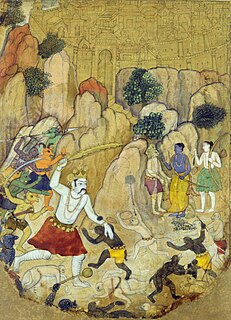 W
WAtikaya was the son of Ravana and his wife Mandodari in the Ramayana epic. Atikaya was the younger brother of Meghanada and was extremely powerful. Once upon a time when he infuriated Lord Shiva atop Mount Kailasha, the God hurled his Trishula at Atikaya, but Atikaya caught the Trishula in mid air and folded his hands before the lord in a humble manner. Lord Shiva was pleased at seeing this, and benevolently blessed Atikaya with the secrets of archery and divine weapons.
 W
WIndrajit or Meghanada, according to Hindu texts, was a prince of Lanka and possessor of Indra Loka (Heaven). He is regarded as one of the greatest warriors in Hindu texts. He was mentioned in the Indian epic Ramayana. Indrajit played an active role in the great war between Rama and Ravana. He acquired many kinds of celestial weapons from his Guru Shukra. He defeated the Gods (Devas) in heaven. Using Brahmastra, Indrajit killed 670 million Vanaras in a single day; nearly exterminating the entire half vanara race. No warrior on the Earth achieved this statistical feat in Ramayana
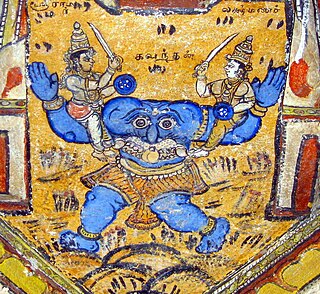 W
WIn Hindu mythology, Kabandha is a Rakshasa (demon) who is killed and freed from a curse by the god Rama – an Avatar of Vishnu – and his brother Lakshmana. Kabandha's legend appears in the Hindu epics Ramayana and Mahabharata, as well as in later Ramayana adaptations.
 W
WKalanemi is a demon in Hindu mythology. He was the son of Hiranyaksha and brother of Andhaka. In this birth as Hiranyaksha's son, he was slain by Lord Vishnu while his brother was killed by Lord Shiva. In one of his rebirths as per his karmic deeds, he was born as Kansa, son of Ugrasena the king of Mathura. His sister was Devaki and her son Krishna was an avatar of Vishnu. Krishna eventually killed Kansa in this birth.In the epic Ramayana Kalanemi was Maricha's son and minister of Ravana and was assigned to kill Hanuman. Jalandhara's wife, Vrinda, was Kalanemi's daughter.
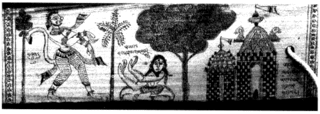 W
WKalanemi is a rakshasa (demon) mentioned in various adaptations of the Hindu epic Ramayana. He is the son of Maricha, who was tasked by Ravana, the epic's main antagonist to kill Hanuman. Although not part of Valmiki Ramayana, his encounter with Hanuman has been described in several versions with variations in details but all concluding in his defeat and killing.
 W
WKumbhakarna is a named rakshasa and younger brother of Ravana in the famous Hindu Legends in the events of Ramayana. Despite his gigantic size and great appetite, he was described to be of good character and great warrior in those times, though he killed and ate many monkeys only to show his power.
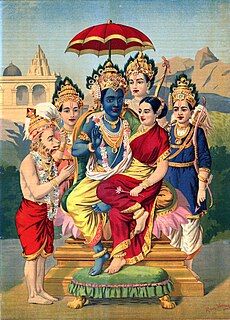 W
WMalyaban or Malyavan was the Chief Royal Adviser to the Emperor of Lanka, Ravana. Malyavan was a respected voice within the intellectual and royal circles in Lanka. It is noted that Malyavan was an intellectual who was well-versed in scriptures and was known for holding his ground, despite being the dissenting voice. Malyavan was a maternal grandfather Of Dashanana.
 W
WMandodari was the queen consort of Ravana, the king of Lanka, according to the Hindu epic Ramayana. The Ramayana describes Mandodari as beautiful, pious, and righteous. She is extolled as one of the Panchakanya, the recital of whose names is believed to dispel sin.
 W
WIn the Hindu epic Ramayana, Maricha, or Mareecha is a rakshasa (demon), who was killed by Rama, the hero of the epic and an avatar of God Vishnu. He is mentioned as an ally of Ravana, the antagonist of the epic. His most notable exploit is his role in the kidnapping of Sita, Rama's wife. His son Kalanemi was killed by Hanuman.
 W
WIn Hindu scriptures, Maya or Mayāsura (मयासुर) was a great ancient king of the asuras, daityas and rākṣasa races. Maya was known for his brilliant architecture. In Mahabharata, Mayasabha – the hall of illusions – was named after him.
 W
WNarantaka and Devanataka are demons and sons of Ravana who appear in a number of Hindu legends. They, along with Atikaya, were created by Ravana from mandodari, the son of devantaka. Mahakantaka was the only survivor of Raksha clan and was pardoned by Lord Rama and his army. He went far into the Kanyakubj desh and started following Brahmanism.
 W
WLankini was a powerful Rakshasi from the ancient Hindu epic Ramayana. Her name literally means "The Deity of Lanka" as she was the female personification of the city itself and was the guardian to the doors of Lanka.
 W
WRavana(;Sanskrit: रावण, IAST: Rāvaṇa, pronounced [ˈraːʋɐɳɐ]) is a king of Lanka and the chief antagonist in the Hindu epic Ramayana and its adaptations. In the Ramayana, Ravana is described to be the eldest son of sage Vishrava and Rakshasi Kaikeshi. He abducted Rama's wife Sita and took her to his kingdom of Lanka, where he held her as a prisoner in Ashok Vatika, and also expressed a desire to marry her. Later, Rama, with the support of vanara King Sugriva and his army of vanars, attacked Ravana in Lanka. They killed Ravana and Rama rescued his beloved wife Sita.
 W
WIn the Ramayana, Sarama is the wife of Vibhishana, the brother of Ravana, the demon (rakshasa) king of Lanka. Sometimes, she is described a rakshasi (demoness), at other times, she is said to have gandharva lineage. All accounts agree that Sarama was friendly to Sita, the consort of Rama, who was kidnapped by Ravana and imprisoned in Lanka. Like her husband who sides with Rama in the war against Ravana, Sarama is kind to Sita and aids Rama. Sarama and Vibhishana had a daughter called Trijata.
 W
WShurpanakha, also known as Meenakshi, is a character in Valmiki's epic, the Ramayana, and is the sister of Ravana, King of Lanka.
 W
WSubahu was a rakshasa character in the Ramayana. He and his mother, Tataka, took immense pleasure in harassing the munis of the jungle, especially Vishvamitra, by disrupting their yajnas with rains of flesh and blood.
 W
WSulochana was daughter of the king of the serpents Sheshanaga, who is mentioned in the Indian epic Ramayana. She was married to Meghanada (Indrajit), who was the eldest son of Ravana, who defeated Indra, hence received his title.
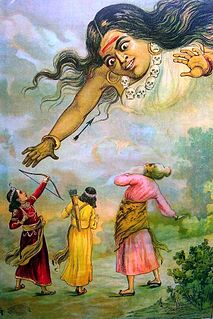 W
WTaraka or Tadaka or Thataka was a demoness in the epic Ramayana. Along with her children, Maricha and Subahu, Taraka would harass and attack rishis performing yajnas in the forest. They were ultimately slain by Rama and Lakshmana on behest of their teacher, maharishi Vishwamitra.
 W
WTrijata is a rakshasi (demoness) in the Ramayana who is assigned the duty of guarding Sita who was kidnapped by king of Lanka Ravana. In latter adaptions of Ramayana, Trijata is describe as a daughter of Vibhishana.
 W
WTrishira was a Rakshasa, and reference to him is found in the Ramayana. He was one of the six sons of Ravana, and his other brothers were Meghanada, Atikaya, Akshayakumara, Narantaka and Devantaka.
 W
WVibhishana is the younger brother of Ravana, the king of Lanka in the ancient Indian epic Ramayana. Though a Rakshasa himself, Vibhishana deserted Ravana and joined Rama's army. Later, when Rama defeated Ravana, Rama crowned Vibhishana as the king of Lanka before returning to Ayodhya.
 W
WVirādha is minor character from the Aranya Kanda of the Ramayana. He is a rakshasa living in Dandaka forest who briefly kidnaps Sita in an episode that has been described as "strongly [prefiguring Sita's] later abduction by Ravana, the central event of the book and the pivotal event of the epic." Rama and Lakshmana begin to battle the monster, but though they shoot it with many arrows, the arrows pass straight through him and leave him unharmed. The monster reveals that he has a boon from Brahma which makes him invincible to weapons. So the brothers kill the rakshasa by first breaking his arms, then burying him alive in a grave. When the monsters arms are broken, he begins to praise the brothers for liberating him: he had, in a previous life, been a celestial being named Tumburu, and had been cursed by Kubera to live as a fearsome monster until he be killed by Rama. The brothers bury him, and he apparently goes back to his former celestial abode.